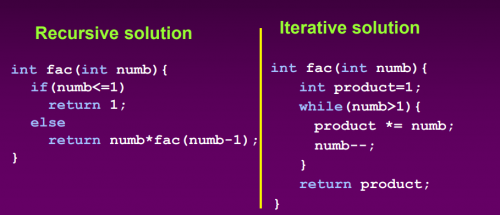Recursion is maybe the easiest yet most problematic concept for the beginners to grasp. But you will get hand of this concept after this Tech-Recipe. Click on “Continue Reading” to read about Recursion and a very easy example.
This tech-recipe will introduce you to the concept of recursion. With the simple example of Factorial of a Number Using Recursion.
What is Recursion
Recur simply means to reoccur or to happen again. Recursion is a major programming concept in Computer science. Recursion is a process in which function calls itself. The function thus would be called a recursive function.
Sometimes it is easier to define the problem in terms of the problem itself. Especially for the problems that can be broken down into simpler versions
Example:
Factorial Problems
6!=6x5x4x3x2x1! —–> 12
Now this problem can be broken down into simpler versions for itself.
We could write
6!=6×5! —–> 12
In general, we can express the factorial function as follows:
n! = n * (n-1)!
Is this correct? Well… almost.
The factorial function is only defined for positive integers. So we should be a bit more precise:
n! = 1 (if n is equal to 1)
n! = n * (n-1)! (if n is larger than 1)
For certain problems, a recursive solution often leads to short and elegant code.
Compare the recursive solution with the iterative solution:
Here’s how you can write a Recursive solution of Factorial Problem
Step-by-Step Procedure:
Factorial of a Number Using Recursion
1. Add required libraries.

2. Make a function that will receive an integer parameter and will return an integer. [So a parameter can be passed to this function. This function will compute the factorial and will return it.]

3. Write the code that will calculate the factorial.

4. A recursive function always has to bottom out. i.e. There will be a final result where the recursion can stop. Otherwise, recursion will continue forever. So make sure you write it’s bottom out.

Note
A recursive function must contain at least one non-recursive branch.
The recursive calls must eventually lead to non-recursive branch.
5. Make a main function

6. Make initialize and declare an integer.
7. Call the factorial function in the main and pass the integer.
8. Be a fancy programmer and print the returned result neatly

And there you have it. You’re first recursive program. Practice this and other questions.
Points to keep in mind
- If we use iteration, we must be careful not to create an infinite loop by accident
- If we use recursion we must be careful not to create an infinite chain of function calls
- Always make sure that the recursion bottoms out


